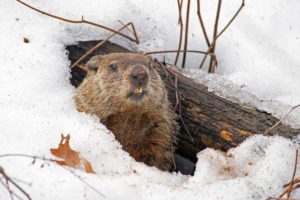Best Groundhog Baits
DID YOU KNOW?
Groundhogs’ burrows can contain up to 45 feet of tunnels and can cause extensive foundation problems.
The best way to ensure this doesn’t happen to you is to take preventative steps.
The Best Groundhog Baits
Groundhogs, which are also known as woodchucks can cause damage not only to yards but also under decks, porches, and sheds, possibly causing damage to the foundation.
If you don’t want to mess around with a live trap and the need to move a woodchuck to another location or don’t want to spend the money on professional pest control, bait poison is an affordable option. We’ve picked some top groundhog baits—all at reasonable or budget-friendly costs.
Groundhog Baits Trap We Reviewed
How We Found the Best Groundhog Baits
7 Reviewers
24 Products Considered
3 Products Reviewed
3 Top Picks
Groundhog Baits Problem?

JT Eaton Bait Blocks
Pros
- Peanut Butter flavored
- Also works for squirrels, chipmunks, mice, and rats
- Easy to use
- 144 blocks per container
Cons
- Can take up to a week of consumption for results
- Dangerous to pets and children
- A rare number of reviewers found it unsuccessful
OUR VERDICT
We like the amount of bait in this bucket as well as the effectiveness. This is ideal for people who have an ongoing or chronic problem with gophers and/or other rodents.
Our Review
When gophers are tearing up your lawn and garden, you want them dealt with quickly and permanently. If they’re inviting themselves to your yard, invite them to a picnic featuring JT Eaton Bait Blocks. With the active ingredient diphacinone, these specially formulated peanut butter flavored blocks attract gophers and eliminate them after they feast.
The blocks are ideal for placing throughout your lawn and garden, and inside gopher tunnels. Placing a multitude of blocks inside the tunnel and topping the entrance with a heavy board or brick should ensure the end of that nuisance.
The pail comes with 144 blocks and a tamper evident resealable lid. JT Eaton even offers a 1-year limited warranty to protect against defects. Family owned and operated since 1932, JT Eaton strive to manufacture and sell only the highest quality products available.
Wear gloves each and every time you place bait blocks or whenever disposing of dead rodents. Be sure to keep this bait out of reach from children and pets.
article continues below

Bonide Moletox Mole and Gopher Killer
Pros
- Well-rated for effectiveness
- Highly appealing bait
- Useful on warfarin-resistant animals
- Affordable
- Plenty of bait for lots of use
Cons
- The lure is appealing to pets if left out.
- Must exercise caution regarding children and pets.
OUR VERDICT
With an appealing lure for groundhogs and a fantastic price, this comes in as our runner-up. The cracked corn bait is a vegetable-based natural part of a groundhog’s diet.
Our Review
Bonide Moletox Mole and Gopher Killer poison is crafted with zinc phosphide (2.0 percent). When an animal eats the zinc phosphide, it turns to a highly toxic gas in their stomach. One teaspoon will treat each active groundhog burrow, making it easy to portion out and distribute. We love the low cost of this groundhog and gopher killer and found it successful if each active tunnel was treated.
This particular rodenticide uses cracked corn as the lure, making it highly attractive to animals such as gophers and groundhogs. Groundhogs most often feed on grasses and vegetables at ground level, so the vegetable-based lure is especially appealing to them.
With a full pound of product in one package, there is plenty of uses in single teaspoon doses. Be sure always to wear gloves while distributing the poison and when disposing of dead rodents. As mentioned, the lure is actual food (cracked corn) so use extreme caution regarding pets and kids.

Tomcat Mole Killer Worm Bait
Pros
- Effective against groundhogs and other burrowing rodents
- Works within a few days
- Only takes a single feeding
- Visually appealing lure.
- Rated highly by users
- Made in the USA
Cons
- On rare occasions, ineffective with a single use
- A smaller amount of bait than some products
- Caution must be used regarding children and pets
OUR VERDICT
The visual food lure of a food source (earthworm) and high ratings make this our favorite worm bait. This is a fantastic option for those who only need a small amount of bait, or who tried other poisons with little success.
Our Review
We like Tomcat Mole Killer Worm Bait for its intelligent design. This poison is shaped like an earthworm, which is an occasional addition to a groundhog’s diet. While groundhogs eat mainly vegetables and grasses, they will supplement their food supply with snails, worms, or grubs.
This is an ideal bait for those who only have a couple of groundhogs to deal with and do not need a large container of poison. To use this worm bait, first, check for active groundhog tunnels. Only 10 worms come in a package, so be sure you have active burrows first. While wearing gloves, place the “worm” deep into an active groundhog burrow where pets or a child cannot reach.
As another method, you can poke a tiny hole in the roof of a groundhog burrow, place the worm inside, and then recover the gap with a stone or bit of sod. Recheck the tunnel for activity a couple of days later. Be sure always to wear gloves when disposing of dead rodents or groundhogs and do so within health law guidelines.
Identifying Groundhogs and Their Burrows
Sometimes a groundhog can be confused with other large rodents such as moles. Groundhogs burrow roughly two to four feet below ground. Their burrows can extend up to 15 to 25 feet. These underground homes often have two to five entrances/exits that will measure roughly six to eight inches with a fresh mound of earth around them.
Additionally, groundhogs have larger heads than moles. A groundhog will tend to measure about 15 to 20 inches in length and have grayish-brown fur with a stout body and stubby legs. Groundhogs tend to emerge in the early morning and in the evening, during these daylight hours, to feed. If you’re a dog owner, this can be troublesome if your dog spots the groundhog and goes nuts every time this burrowing animal emerges.
What Groundhogs Eat
Groundhogs come out to feed mostly during the early morning and evening daylight hours. They feast primarily on grasses and vegetables. Occasionally, they will also consume grubs, worms, and snails. If you have fruits and vegetables within their reach, woodchucks can take out a whole garden in one day.
They can also cause massive damage to agricultural crops and will eat berries, corn, apples, carrots—nearly any edible fruits and vegetable they have access to.
How to Catch a Groundhog
If you have tall grass or an ample garden for groundhogs to feast on, it can be helpful to cut your grass short, and harvest your garden in the lower areas groundhogs can reach. This is by no means necessary, but reducing their food supply will make baiting these animals easier.
If you have pets, keep them inside during times the groundhog might emerge to feed on the bait, so they aren’t scared off before they get to it.
Adding to Bait
Even when using bait with an enticing lure, you can always add food to the mix to make it more appealing to groundhogs. Sweetly scented fruits like cut strawberries or cantaloupe work particularly well as a groundhog lure. If you mix bait blocks, granules, or even a bait “worm” in with just a little fresh fruit, you’ll increase your chances of getting woodchucks to eat the bait.
Check After Setting
After groundhog bait is set, wait a couple of days and check the area for signs of activity or dead rodents. Most poisons will take two to three days to work, although some will be effective within one full day. Depending on your situation and the constitution of the animal, it may take a couple of doses.
Regardless, use the utmost caution when setting bait. Keep in mind other animals will likely find these baits appealing, too, especially if mixed with fresh food. So, be sure to apply the poison deep within a groundhog tunnel and out of reach from kids and pets. Once you find a dead rodent, wear gloves and dispose of them quickly according to health laws in your area.
Summary
Groundhogs will often burrow deeper than animals such as moles and more often near trees, under decks or porches, even under homes on a slab. This means they hold the potential for very expensive costs in damage not only to crops and gardens, but also to decks, tree roots, and underground wires or plastic piping.
Live traps or calling a pest professional are options. However, if you’re tight on funds or do not have a place to relocate a live animal, these baits are an affordable, straightforward option. Be sure to use the proper cautionary measures, bait properly, and you should have a groundhog-free yard in a short time.





